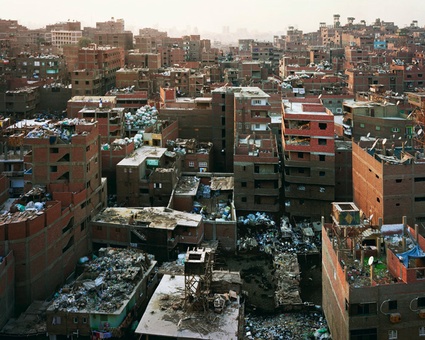Garbage City

Cairo, the capital of Egypt, is one of the largest urban areas in the world, with over 6.5 million residents in the city itself and roughly 18 million in the greater metro area. And it is like most cosmopolitan cities — except for one interesting difference:
Garbage.
Cairo’s municipal waste system — which handles about 9,000 tons of garbage a day — is not much of a system at all. It is, at best, an informal undertaking. The city’s municipal garbage needs are driven by a subset of the population known as the Zabbaleen (literally, “garbage people” in Egyptian Arabic), a group of mostly Coptic Christians numbering around 60-70,000, who have been the city’s de facto garbage collectors for decades. They live in a half-dozen or so communities in the outskirts of Cairo, collecting trash and refuse from virtually every street corner in Cairo.
But where the garbage ends up is, perhaps, the real story. The Zabbaleen collect the trash in a village named Manshiyat Naser, a slum, with stores and dwellings, avenues and roads, but without a sewer system, running water, or electricity. And as seen in the photos here, the streets of the village are, figuratively, paved in trash. For this, the village has earned the moniker “Garbage City.”
At Manshiyat Naser, the Zabbaleen work their magic with the refuse of others, sorting through tons and tons of it for items which can be reused or recycled — or, in the case of food, fed to pigs. (When the swine flu made its way around the world, the Egyptian government ended that practice.) Families specialize in types of garbage, and thereby are able to better pick out treasure from, well, actual trash. And the results are apparently spectacular — according to a 2010 documentary about the Zabbaleen and Manshiyat Naser, as much as 80% of the garbage can be repurposed. For comparison’s sake, most recycling methods recover only about a quarter of items thrown away.
The Zabbaleen’s future, however, is up in the air. The culling of pigs due to the swine flu scare wreaked havoc on their economy. Combined with Egypt and Cairo’s (pre-revolution) desire to become more modern and turn garbage collection into a municipal service, the Zabbaleen’s role in Cairo’s garbage economy may be on the wane.
Bonus fact: According to Dr. Robin Nagle, anthropologist-in-residence at the New York City Department of Sanitation (it’s a part-time job), “sanitation workers are at greater risk of on-the-job injury and on-the-job fatality than police officers or fire fighters.”
From the Archives: The Great Pacific Garbage Patch: Lots of garbage, afloat at sea.
Related: Garbage Dreams, the above-mentioned documentary about the Zabbaleen.

Leave a comment